Neanderthal News 2020 - Lifestyles
- Neanderthals of Figueira Brava, Portugal, had rich diet of mussels, fish and seals, archaeologists say.
- Neanderthals Dived into Mediterranean Sea for Clam Shells
- Neanderthals Knew How to Start Fire, New Research Shows
- UCD research: Neanderthals, not modern humans, made first bone tools
- Neanderthals Made Leather-Working Tools from Bison and Aurochs Ribs
- See also in Q-MAG.org: Neanderthal made strings
Neanderthals of Figueira Brava, Portugal, had rich diet of mussels, fish and seals, archaeologists say.
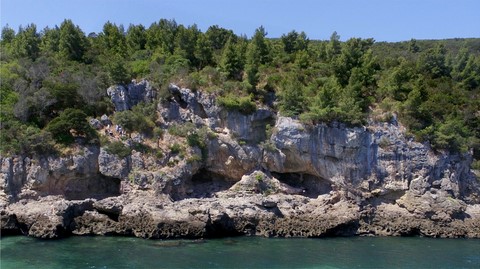
The Figueira Brava Neanderthal cave with its three entrances
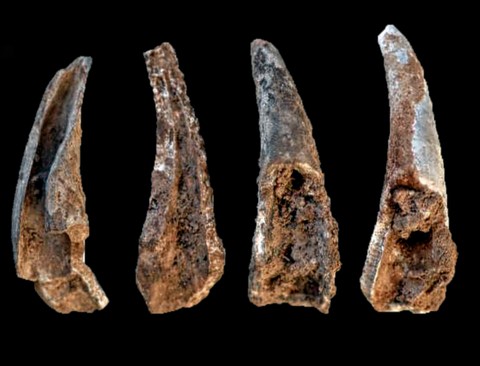
Burnt crab pincers from Figueira Brava cave
International research team with participation from University of Göttingen find it wasn’t just Homo sapiens who sourced food from the sea – impact on cognitive abilities suspected
Over 80,000 years ago, Neanderthals were already feeding themselves regularly on mussels, fish and other marine life. The first robust evidence of this has been found by an international research team with the participation of the University of Göttingen during an excavation in the cave of Figueira Brava in Portugal. Dr Dirk Hoffmann at the Göttingen Isotope Geology Department dated flowstone layers - calcite deposits that form like stalagmites from dripping water - using the uranium-thorium method, and was thus able to determine the age of the excavation layers to between 86,000 and 106,000 years. This means that the layers date from the period in which the Neanderthals settled in Europe. The use of the sea as a source of food at that time has so far only been attributed to anatomically modern humans (Homo sapiens) in Africa. The results of the study were published in the journal Science.
The cave of Figueira Brava is located 30 kilometres south of Lisbon on the slopes of the Serra da Arrábida. Today it is located directly on the waterfront, but at that time it was up to two kilometres from the coast. The research team, coordinated by the first author of the study, Professor João Zilhão from the University of Barcelona, found that the Neanderthals living there were able to routinely harvest mussels and fish, and to hunt seals. Their diet included mussels, crustaceans and fish as well as waterfowl and marine mammals such as dolphins and seals. Food from the sea is rich in omega-3 fatty acids and other fatty acids that promote the development of brain tissue.
Until now, it has always been suspected that this consumption increased the cognitive abilities of the human populations in Africa.
"Among other influences, this could explain the early appearance of a culture of modern people that used symbolic artefacts, such as body painting with ochre, the use of ornaments or the decoration of containers made of ostrich eggs with geometric motifs," explains Hoffmann. "Such behaviour reflects human's capacity for abstract thought and communication through symbols, which also contributed to the emergence of more organised and complex societies of modern humans".
The recent results of the excavation of Figueira Brava now confirm that if the habitual consumption of marine life played an important role in the development of cognitive abilities, this is as true for Neanderthals as it is for anatomically modern humans. Hoffmann and his co-authors previously found that Neanderthals made cave paintings in three caves on the Iberian Peninsula more than 65,000 years ago and that perforated and painted shells must also be attributed to the Neanderthals.
Original publication: J. Zilhão et al., Last Interglacial Iberian Neandertals as fisher-hunter-gatherers, Science, 10.1126/science.aaz7943
Original article on the site of University of Göttingen.
Neanderthals Dived into Mediterranean Sea for Clam Shells
Shell fishing was a common activity of Neanderthals, according to new research led by University of Colorado, Boulder archaeologists.
In 1949, archaeologists working at the site of Grotta dei Moscerini, a cave in the Latium region of central Italy, found a large collection of unusual artifacts: 171 shells of the smooth clam (Callista chione) that Neanderthals had picked up and shaped into sharp tools roughly 90,000 years ago.
According to the new study, Neanderthals didn’t just collect shells that were lying out on the beach, they may have actually held their breath and went diving for the perfect shells to meet their needs.
“Our results show that Neanderthals may have had a much closer connection to the sea than many scientists thought,” said Dr. Paola Villa, an adjoint curator at the University of Colorado, Boulder’s Museum of Natural History. “The fact they were exploiting marine resources was something that was known. But until recently, no one really paid much attention to it.”
When archaeologists first found shell tools in Grotta dei Moscerini, it came as a surprise.
While Neanderthals are well-known for crafting spear tips out of stone, few examples exist of them turning shells into tools.
“The ancient humans used stone hammers to chip away at these shells, forming cutting edges that would have stayed thin and sharp for a long time,” Dr. Villa said. “No matter how many times you retouch a clam shell, its cutting edge will remain very thin and sharp.”
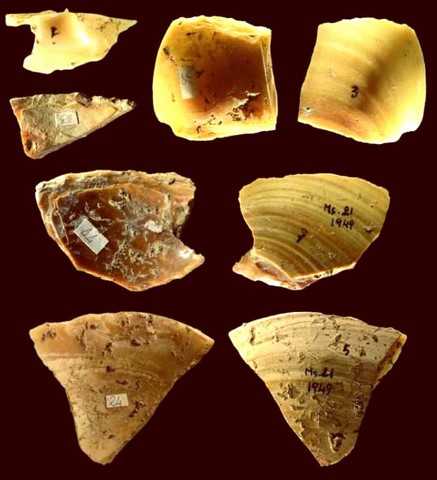
A collection of shell tools discovered in Grotta dei Moscerini in 1949. Image credit: Villa et al, doi: 10.1371/journal.pone.0226690.
But did the Neanderthals, like many beachgoers today, simply collect these shells while taking a stroll along the sand? To find out, Dr. Villa and her colleagues took a closer look at those tools.
They found something they weren’t expecting. Nearly three-quarters of the Moscerini shell tools had opaque and slightly abraded exteriors, as if they had been sanded down over time.
“That’s what you’d expect to see on shells that had washed up on a sandy beach,” Dr. Villa said.
The rest of the shells had a shiny, smooth exterior. Those shells, which also tended to be a little bit bigger, had to have been plucked directly from the seafloor as live animals.
“It’s quite possible that the Neanderthals were collecting shells as far down as 2 to 4 m (6.5-13 feet). Of course, they did not have scuba equipment,” Dr. Villa said.
The study was published in the journal PLoS ONE. P. Villa et al. 2020. Neandertals on the beach: Use of marine resources at Grotta dei Moscerini (Latium, Italy). PLoS ONE 15 (1): e0226690; doi: 10.1371/journal.pone.0226690
This article is from sci-news.com
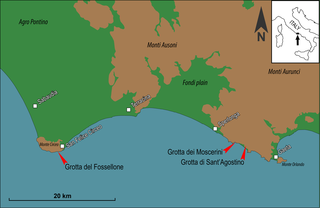
Excavated in 1949, Grotta dei Moscerini is one of two Italian Neandertal sites with a large assemblage of retouched shells from 21 layers. The other occurrence is from the broadly contemporaneous layer L of Grotta del Cavallo in southern Italy. Eight other Mousterian sites in Italy and one in Greece also have shell tools but in a very small number. The shell tools are made on valves of the smooth clam Callista chione. The general idea that the valves of Callista chione were collected by Neandertals on the beach after the death of the mollusk is incomplete. At Moscerini 23.9% of the specimens were gathered directly from the sea floor as live animals by skin diving Neandertals. Archaeological data from sites in Italy, France and Spain confirm that shell fishing and fresh water fishing was a common activity of Neandertals, as indicated by anatomical studies recently published by E. Trinkaus. Lithic analysis provides data to show the relation between stone tools and shell tools. Several layers contain pumices derived from volcanic eruptions in the Ischia Island or the Campi Flegrei (prior to the Campanian Ignimbrite mega-eruption). Their rounded edges indicate that they were transported by sea currents to the beach at the base of the Moscerini sequence. Their presence in the occupation layers above the beach is discussed. The most plausible hypothesis is that they were collected by Neandertals. Incontrovertible evidence that Neandertals collected pumices is provided by a cave in Liguria. Use of pumices as abraders is well documented in the Upper Paleolithic. We prove that the exploitation of submerged aquatic resources and the collection of pumices common in the Upper Paleolithic were part of Neandertal behavior well before the arrival of modern humans in Western Europe.
Neanderthals Knew How to Start Fire, New Research Shows
Middle Paleolithic hominins such as Neanderthals not only controlled fire, but also mastered the ability to generate it, according to new research led by University of Connecticut scientists.
“Fire was presumed to be the domain of Homo sapiens but now we know that other ancient humans like Neanderthals could create it. So perhaps we are not so special after all,” said Dr. Daniel Adler, a researcher in the Department of Anthropology at the University of Connecticut.
Dr. Adler and his colleagues from Armenia, the U.S., the U.K., and Spain, looked at sediment samples from Lusakert Cave in the Armenian Highlands to determine the abundance of polycyclic aromatic hydrocarbons (PAHs), which are released when organic material is burned.
One type of PAH called light PAHs, disperse widely and are indicative of wildfires while others, called heavy PAHs, disperse narrowly and remain much closer to the source of fire.
“Looking at the markers for fires that are locally made, we start to see other human activity correlating with more evidence of locally-made fire,” said lead author Alex Brittingham, a doctoral student at the University of Connecticut.
Evidence of increased human occupation at the Lusakert Cave site, such as concentrations of animal bones from meals and evidence of tool making, correlated with increased fire frequency and the increased frequency of heavy PAHs.
The team also needed to rule out the possibility that unsettled weather, which gives rise to lightning, had ignited the fires.
To do so, the scientists analyzed hydrogen and carbon isotope composition of the waxy cuticles of ancient plant tissues preserved in sediments. The distribution of these leaf waxes indicate what kind of climate the plants grew in
“We could not find any evidence of a link between overall paleoclimatic conditions and the geochemical record of fire,” said Dr. Michael Hren, also from the University of Connecticut. “In order to routinely access naturally caused fires, there would need to have been conditions that would produce lighting strikes at a relative frequency that could have ignited wildfires.”
By pairing the climate data with the evidence found in the archaeological record, the researchers then determined the cave’s inhabitants were not living in drier, wildfire-prone conditions while they were utilizing fires within the cave.
“In fact, there were fewer wildfires for these ancient humans to harvest at the time when fire frequency and heavy PAH frequency was high in the cave,” Brittingham said. “It seems they were able to control fire outside of the natural availability of wildfires.”
The study was published in the journal Scientific Reports. Alex Brittingham et al. 2019. Geochemical Evidence for the Control of Fire by Middle Palaeolithic Hominins. Scientific Reports 9, article number: 15368; doi: 10.1038/s41598-019-51433-0
This article is from sci-news.com
UCD research: Neanderthals, not modern humans, made first bone tools
One day in 2011, undergraduate student Naomi Martisius was sorting through tiny bone remnants in the UC Davis paleoanthropology lab when she stumbled across a peculiar piece.
The bone fragment, from a French archaeological site, turned out to be a part of an early specialized bone tool used by a Neandertal before the first modern humans appeared in Europe.
“At the time, I had no idea about the impact of my discovery,” said Martisius, who is now pursuing her doctoral degree in anthropology at UCD.
“Previously these types of bone tools have only been associated with modern humans,” said Teresa E. Steele, associate professor of anthropology, who also served as a co-author on the article and adviser to Martisius at UCD and at archaeological excavations in France. “However, our identification of these pieces in secure Neandertal contexts leaves open the possibility that we have found, for the first time, evidence that Neandertals may have influenced the technology of modern humans.”
Used to smooth tough animal hides, the tools were made about 50,000 years ago by Neandertals. The specialized tools are still used today, in similar form, to smooth and refine leather made into high-end purses and jackets.
The bone tools were found in deposits containing typical Neandertal stone tools and the bones of hunted animals including reindeer, red deer and bison. Three of the four pieces were from the site of Abri Peyrony, France.
The animal bones from that site had been exported to Davis for analysis in Steele’s lab where Martisius worked with her to study the material.
Now in her second year of doctoral studies, Martisius will carry on her research of these pieces. She, Steele and their colleagues will conduct experimental studies to manufacture — and use — new, similar animal bone tools for comparison.
Using sophisticated imaging techniques, Martisius will examine the pieces made by the Neandertals, comparing those with the ones first made by the first modern humans in Europe and the ones she manufactures. She also will look at animal bones from nearby sites to see if she can identify additional pieces made by Neandertals.
The tools described in their current work were recovered in archaeological sites in the French countryside that had been explored for more than 100 years, but modern archaeological techniques enabled researchers to recognize these smaller pieces now identified as pieces of once-sophisticated tools, Steele said.
Karen Nikos
– UC Davis News Service (edited by AM de G)
https://www.davisenterprise.com/local-news/ucd/ucd-research-neandertals-not-humans-made-first-bone-tools/
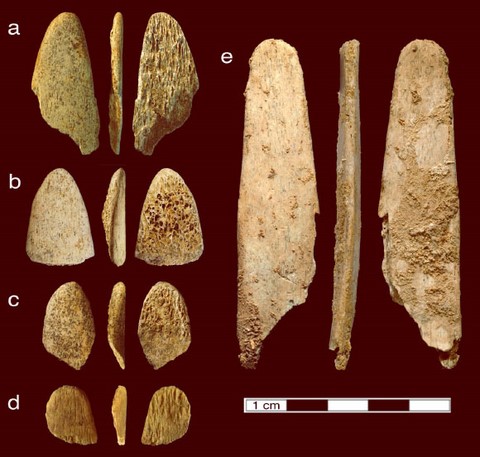
Photographs of Pech-de-l’Azé I (a) and Abri Peyrony (b-e) lissoirs. Image credit: Martisius et al, doi: 10.1038/s41598-020-64358-w.
Neanderthals Made Leather-Working Tools from Bison and Aurochs Ribs
Neanderthals selected rib bones from specific animals to make the lissoirs (French for ‘smoothers’), which are bone tools that have been intentionally shaped and used on animal hides to make them softer and more water resistant, according to new research led by paleoanthropologists from the University of California, Davis.
Scientists know that some Neanderthals produced bone tools. These include the discovery of five nearly identical fragments of lissoirs from two Paleolithic sites in southwest France: Pech-de-l’Azé I (Pech I) and Abri Peyrony.
These specialized tools are often worn so smooth that it’s impossible to tell which animal they came from just by looking at them.
Naomi Martisius from the Department of Anthropology at the University of California, Davis and colleagues used a technique called Zooarchaeology by Mass Spectrometry (ZooMS) to look at residues of collagen protein from Pech I and Abri Peyrony lissoirs. The ZooMS method breaks up samples into fragments that can be identified by their mass to charge ratio and used to reconstruct the original molecule.
Normally, this method would involve drilling a sample from the bone. To avoid damaging the precious specimens, the researchers were able to lift samples from the plastic containers in which the bones had been stored and recover enough material to perform an analysis.
The results show that the bones used to make the lissoirs mostly came from animals in the cattle family, such as bison (Bison sp.) or aurochs (Bos sp.).
But other animal bones from the same deposit show that reindeer (Rangifer tarandus) were much more common and frequently hunted for food.
So the Neanderthals were choosing to use only ribs from certain types of animals to make these tools.
“I think this shows that Neanderthals really knew what they were doing,” Martisius said. “They were deliberately picking up these larger ribs when they happened to come across these animals while hunting and they may have even kept these rib tools for a long time, like we would with a favorite wrench or screwdriver.”
Bovine ribs are bigger and more rigid than deer ribs, making them better suited for the hard work of rubbing skins without wearing out or breaking.
“Neanderthals knew that for a specific task, they needed a very particular tool. They found what worked best and sought it out when it was available,” Martisius said.
The findings were published in the journal Scientific Reports. L. Martisius et al. 2020. Non-destructive ZooMS identification reveals strategic bone tool raw material selection by Neandertals. Sci Rep 10, 7746; doi: 10.1038/s41598-020-64358-w
This article is from sci-news.com

